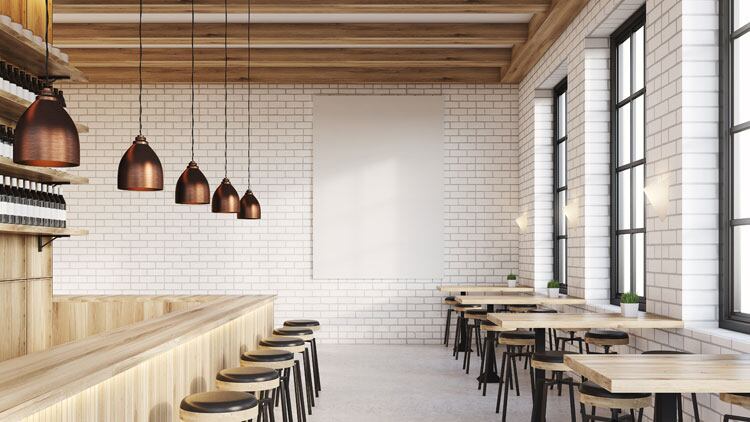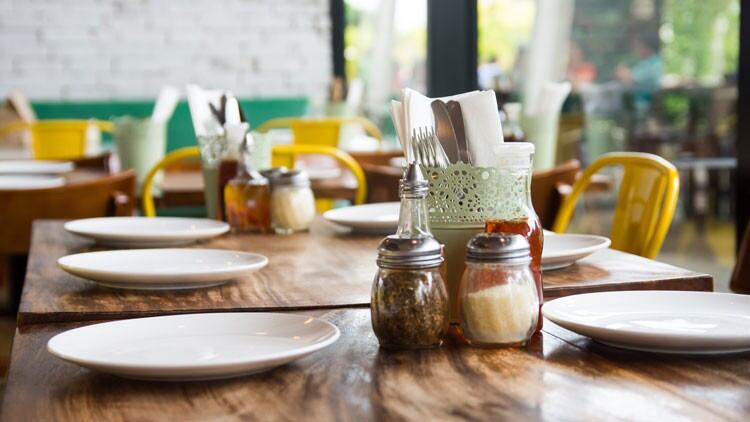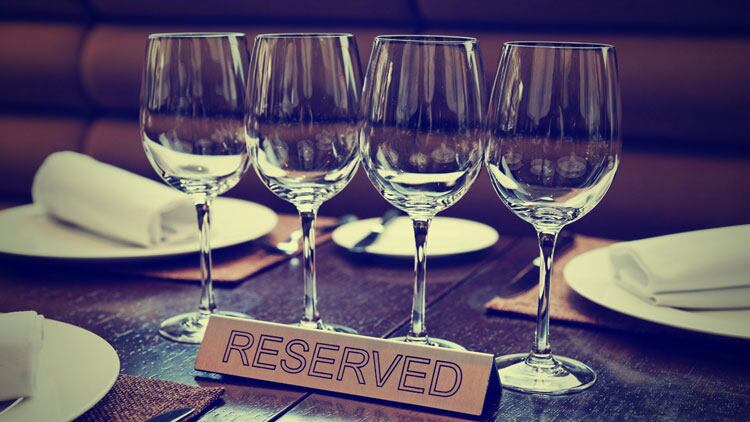Is the restaurant industry facing a no-shows epidemic? It can certainly feel that way when every time you open Twitter or Instagram another chef is fuming about empty tables. After his 2018 ‘Mother’s Day massacre’ at Brunswick House, Jackson Boxer wrote in The Observer of “guests… cynically screwing us, without a thought to the implication.”
Data generated by online-booking brands (ironically, the very people blamed by many for this current crisis), broadly reinforces the idea this is a significant problem; even if booking sites report far lower no-show rates (around 2-5%) than operators (5-20%, anecdotally). ResDiary has estimated no-shows cost the industry £16bn a year, and Quandoo has found that no-shows are 20% higher in London than in Berlin or Milan.
“Whether you’re a multi high street brand or a boutique independent restaurant, no-shows eat into profits and can threaten the very existence of a business,” says David Charlton, commercial director at liveRes. “Average [restaurant sector] profit margins are 3-5% so in an industry where margins are notoriously tight it only takes a handful of no-shows to turn a profit into a loss.”
In the shift from phone to online bookings, critics insist that the guest’s personal connection to restaurants has been lost. “We tend to find 25% of people who book online don’t turn up. Booking on an app, people don’t feel they’ve let the restaurant down if they [no-show]. There are serial multiple bookers who literally don’t care, who book four restaurants and decide on the day,” says Barry Hilton, who runs two Levantine restaurants, called Ceru, in London.
That potential online disconnect is acknowledged by ResDiary in its Restaurant No-Shows Guide. It encourages restaurants to take greater individual, branded control of their booking micro-site and emails. It admits there may be “some truth” in the idea that: “If you book on an anonymous site with a boring confirmation email, you don’t feel like you’ve booked into a place with real people, making a real living.”
OpenTable rejects the idea it has increased no-shows. It recently launched its Book Responsibly campaign (33.7% of people have no-showed at some point; Generation Z are the worst offenders) but, reviewing its own proprietary data, insists phone bookings generate a marginally higher percentage of no-shows than online – 4.6% to 4.4%. With its reservation reminders, instant cancellation and table-release software, OpenTable sees itself as, not part of the problem, but the solution.

To ban or not to ban?
No-shows have always existed. OpenTable has seen no recent spike and it is working to “minimise” them, according to its European VP, Adrian Valeriano. “Diners are prohibited from booking multiple reservations during the same [time] period and we prohibit users from making further reservations should they no-show four times within 12 months,” he says.
But are bans effective? Surely offenders can simply re-register using a different email? “It can be tricky to address multiple accounts,” concedes Valeriano.
Charlton certainly doesn’t believe in banning no-show offenders. “We have a commitment to help businesses be as successful and profitable as possible. I guess the limelight falls on us as what are we going to do about it? But banning consumers who fail to show up – is that the right course of action? When you think about what that achieves, there’s precious little education around the impact of [a diner’s] actions, there is no behavioural reform or insight into the problem, it’s just a superficial reaction.”
Matt Simpkin, vice president for Western Europe at online booking company Quandoo, echoes this view. “We do not believe that reducing the ease of a diner’s journey is the right solution, such as not allowing future reservations for serial offenders,” he says.
Given that, ResDiary is pushing its Stripe payment-processing technology as the ultimate weapon against no-shows. Using it, deposits and full payment can be taken in advance, or credit card details held securely and charged in the event of a no-show (OpenTable also includes this feature). “If diners are determined to make bookings using different email addresses, they will. Realistically, a form of payment is the only way to stop venues losing money because of it,” says a ResDiary spokesperson.
Yet many operators see deposits as a last resort, preferring to deal with no-shows in other ways. For instance, those running busy, fast-casual restaurants in high footfall areas find no-shows an irritation, but one they can counteract. Radically, they could ban bookings and go solely walk-in but, says Hilton, that is only tenable at a minority of very hot restaurants. “People expect to book,” he says. “A younger demographic [may queue], but your average Londoner doesn’t expect to stand in line like they might have six years ago.”
That change has been driven by the simplicity of making online bookings. To deal with it, most busy restaurants now take bookings for 50–75% of their tables, but retain space for walk-ins to cover the inevitable no-shows. “The direction of travel is more people are booking, even in drop-in restaurants,” says David Fox, who owns six East Street and Tampopo restaurants in Manchester and London. “It’s up 40% here and, given the over-supply of restaurants in my space, gone are the days when restaurants could say we don’t take bookings.”
No-shows are an occupational hazard, but one Fox can manage, for now: “I cater for what the market demands. Where it’s a real issue is small, suburban bistros, where if an eight doesn’t show on Thursday night they really feel it.”
How those small independents deal with that is a moot point. Everything from customer education (“education won’t solve it because, ultimately, people are lazy fuckers,” sighs Fox), to blacklisting repeat offenders, has been suggested. Overbooking your restaurant is another tactic but, unless you turn your tables swiftly and have a large bar-cum-waiting area, it can be counterproductive.
A ticking time bomb?
This brings us back to that contentious solution of a financial security. Chef-owner Alex Rushmer is using the pre-payment ticketing system Tock at his new Cambridge restaurant Vanderlyle. “It’s just 26 covers and, given how tight margins are at the moment, no-shows would have hit us way too hard,” he says. Pre-paid is a little risky, he admits, but Rushmer ran two fortnight-long pop-ups to test whether Cambridge was ready for it and says the response was incredible. “We sold 75% of tickets for April and May before publishing a menu.”
Wary of being seen as draconian, however, Vanderlyle has tweaked the standard Tock T&Cs. The restaurant permits refunds with seven days’ notice and will, ‘case-by-case’, even consider refunding guests their £55 after that point. No restaurant wants the PR disaster of, say, a recently bereaved or unemployed guest begging for a refund on social media.
In that way, and several others, Hilton sees the regular comparison between food and other forms of leisure that people routinely pay upfront for, such as football matches and gig tickets, as specious.
“Theatres play one show for a [limited time]. Restaurants are open all week and there’s 20,000 of them in London at least. That’s the difference here. There’s an over-supply of everyday restaurants, where people don’t expect to pay deposits.”
In such a competitive market, any barrier to uptake is “dangerous” says Fox. Unexpectedly, Victoria Roberts, who co-owns York’s Le Cochon Aveugle and the wine bar-cum-bistro Cave du Cochon, agrees. The high-end Le Cochon holds credit card details, charging evening no-shows £50 per-head. It has been, “a huge deterrent”, eradicating no-shows with almost no customer backlash, she insists.
Yet Roberts is unwilling to introduce charges at her more casual Cave venue. “It’s very frustrating, but to a degree we have to accept [no-shows],” she says. Deposits would run contrary to Cave’s “welcoming, approachable” feel. Roberts fears that locals, who regularly drop-in at present, may begin to perceive Cave as a destination where you must book, and use it less often.

The unreliability of deposits
Fundamentally, people are increasingly happy to give their card details to secure big-ticket meals. But, says Hilton, those same guests – even in London, and younger diners, too – are reluctant, particularly over the phone, to hand over their card details to secure a table where the spend-per-head is far less. Casual restaurants, he figures, are perceived as unreliable. “Their business isn’t holding credit card details, so god knows what will happen if I hand them across.”
Quandoo recently did a trial with one large restaurant group whereby it asked for a credit card to hold reservations made in trial restaurants. Conversion from viewing to reservation did drop in the test restaurants but, after marking for no-shows, revenue was slightly increased in the test restaurants, its says. That said, the company is sceptical that many large restaurants groups are likely to employ an approach such as this.
“This is the most effective way to minimise no-shows but I understand the nerves on creating barriers to booking and this is not likely to be used widely any day soon,” says Simpkin. “There are simpler tools out there to minimise the effects of no-shows for both restaurant and diner as a starter while avoiding credit card booking.”
Hilton also warns that in high-turnover restaurants, if you are taking deposits manually by phone (which Ceru does on key dates such as Mother’s Day), staff can get bogged down in processing and, as guests cancel, refunding their deposits.
Yet, up in the Lancashire mill-town of Ramsbottom, across two highly-rated Spanish venues, Levanter and Baratxuri, co-owner Fiona Botham has found deposits a godsend. These small 22 and 30 cover spaces both charge a £10-a-head deposit for adults – but not children, to avoid the deposit being more than they would have spent.
“It’s been really positive. People get it – it’s ten quid, done – rather than being asked to leave their card details, not knowing what amount might be debited,” says Botham, who allows guests to cancel up to 24-hours in advance. “I can count on one hand the people who’ve refused to book, and I can count on one hand the no-shows. It’s a bit of a pain, but it’s rare – one or two a month.”
Once the team got across the legal and data security issues around handling a lot of customer-not-present card transactions (talk to your merchant services’ provider; make sure booking conditions are clearly communicated), the only real problem has been the hard work fielding booking calls and emails, says Botham. Consequently, she is moving the booking online at ResDiary.
Monthly fees and/or transaction charges will apply to the deposits, but it will be cost-effective, she believes. “We can’t get to the phone during service and we can’t dedicate someone to answering it.”
Will deposits work for every restaurant? Clearly not. “It’s an intractable problem, which will grow because more people are booking,” predicts Fox.
But in this battle against no-shows, it is equally clear that those who can charge would be crazy not to.
How to counteract no-shows
It might sound counter-intuitive, but the best way to deal with no-shows is to make it as easy as possible for diners to cancel their bookings, argues one reservation systems company.
David Charlton, commercial director at liveRes, says that rather than encouraging people to make numerous bookings, safe in the knowledge they can make simple cancellations later, by facilitating cancellations restaurants put themselves on the front foot when it comes to tackling no-shows.
“Nobody likes to receive a cancellation but it’s more preferable than a no-show,” he says. “If they do cancel, is it lost money or an opportunity to resell the table? A lot of restaurants are worried about doing that because of any operational impact. A cancellation is not joyful but it is the lesser of two evils. If you know about it in advance, you can try to resell a table or manage staffing levels.
Ignorance is definitely not bliss, there is no point in having a full team of staff with no one to serve.”
How a restaurant enables cancellations is down to personal preference, says Charlton. “It’s like building a friendship, you want your customers to treat you as if they were your friend. You have a duty of responsibility to make sure they are still coming, but how do you do that? You can give them a call, or send a text message or email reminder. Or if you’re feeling very brave and on good terms with them, even drop them a WhatsApp message.”
According to Charlton, research shows that text messaging is the best channel to get a response. He gives a recent example of a liveRes customer in Manchester that saw no-shows drop from 19% to 5% as a result of sending out SMS reminders. “The key is to keep it as simple as possible,” he adds. “One simple question and call to action, then job done.”

Enabling easy cancellations is just one prong of an attack to counteract the challenge of no-shows. Another is implementing zero lead time availability on reservations. This allows guests who want to make an immediate booking to do so with only 15 minutes’ notice required and, while it sounds crazy, can be very effective, says Charlton. He cites a large UK pub company that moved to zero lead time availability in all its venues and recorded double-digit growth in bookings as a result. A significant proportion of that growth came from SMS reminders resulting in cancellations, with the company then able to resell the tables in real-time across all its channels.
Quandoo is another advocate of making it easier for diners to cancel in order to reduce no-shows. “Our reminder mails alert the diner to cancel a meal they are no longer planning to take and these can be customised by the restaurants as needed,” says Matt Simpkin, vice president for Western Europe at Quandoo. “This remains the reason why online reservations tend to have a higher cancellation but lower no-show ratio as people find it easier to cancel with a button than make a phone call.”
The company also says that restaurants should work with their digital partners to remove what it calls the ‘pain points’ of reserving, paying and ordering, and in this way treat the technology this requires as a way to reduce no-shows. “Stop looking for technology to eradicate no-shows and look for tools that can work in parallel to improve the ease of transactions and reduce no-shows in parallel,” says Simpkin.
“Think of an app linking payment tools for use both pre and post dining and combining this with an incentive to use. For example, pre-order a (discounted) pre-dinner drink when reserving with your (already) stored card and get the drinks on check-in at the restaurant. This will reduce no-shows, improve bill size and, most importantly, ensure the diner is more likely to show up and enjoy their experience knowing there will be a drink on their table shortly after arriving at the restaurant and before placing their food order.
“In this way, we are using the consumer technology that reduces their pain points of ordering, paying, getting a waiter’s attention to also reduce no-shows for the restaurants. Restaurants can learn a lot from other industries by looking at how digitalisation can reduce pain points for both diner and restaurant. Tackling with big sticks is not the right solution.”
This is a web version of an article that first appeared in the May issue of Restaurant magazine, the leading title for the UK's restaurant industry. For more features, comment, interviews and in-depth analysis of the restaurant sector subscribe to Restaurant magazine here.
Follow Tony on Twitter: @naylor_tony

